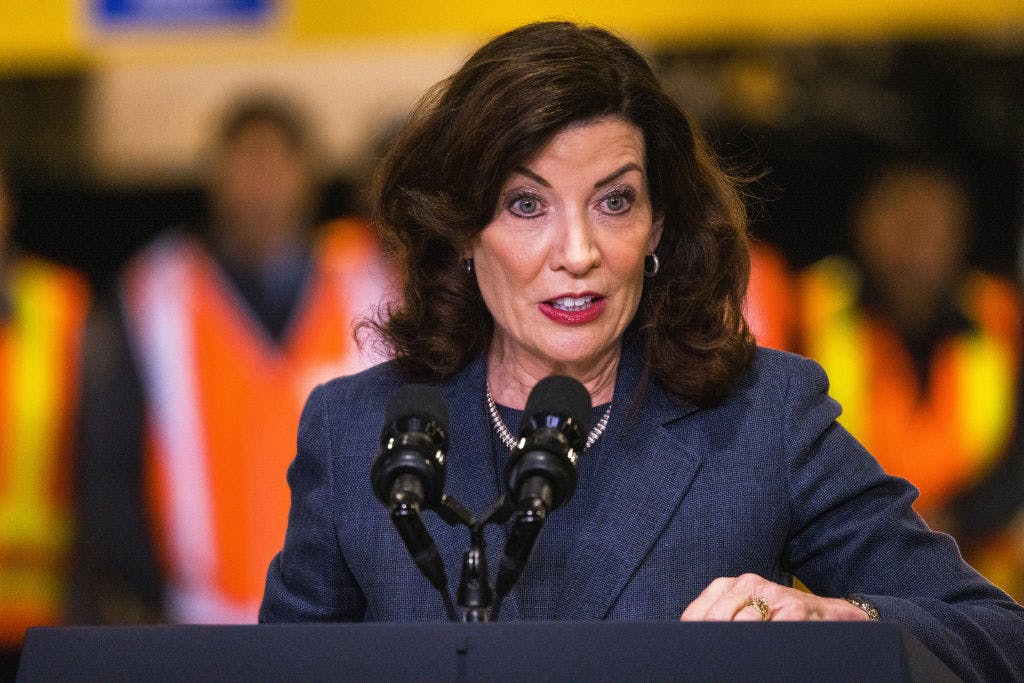Concern Grows Over How New York City Will Fund Its New Class-Size Mandate — and Whether It Will Help Students at All
While proponents of Governor Hochul’s initiative to reduce class sizes argue it will bolster the quality of education across New York City public schools, an educational advocate warns ‘it will have the opposite effect.’

As students go back to school this week, concerns are growing that a new law to limit class sizes in New York City public schools might undermine the quality of education in classrooms across the city while straining state funding.
Governor Hochul’s initiative requires the city to reduce class sizes in at least 20 percent of its schools each year through 2028, capping most classes at 25 pupils. The state department of education would need to hire up to 17,700 additional teachers.
That could cost between $1.6 billion and $1.9 billion annually, a July 2023 report by the New York City Independent Budget Office discloses. From where exactly these funds might come — and how much, if at all, it might improve the quality of education in the classroom — is a matter of dispute between education leaders and city officials.
Ms. Hochul said she plans to “make sure that the children who were so adversely affected by this disconnect from normal life” during the Covid pandemic can have “more individualized attention” at school, according to her statement when the bill was signed into law last September.
Mayor Adams has criticized the class-size initiative as an “unfunded mandate.” The labor union representing most New York City public school teachers, United Federation of Teachers, suggests that the mandate would be subsidized by $4.6 billion in unspent federal Covid education funds and $1.3 billion in recurring foundation aid, a formula established in 2007 that is due to be fully phased in for the first time in the 2023-24 academic year.
The aim is, ostensibly, to “address student performance and need,” according to the state aid handbook. Yet an education policy analyst at the think tank Empire Center for Public Policy, Emily D’Vertola, is skeptical of UFT’s claim that the law pertaining to class size is a “funded mandate.”
“Our funding formula is informed by outdated Census data, is not accurately tied to schools’ yearly enrollment, and is due for an overhaul,” Ms. D’Vertola tells the Sun. “Pandemic relief aid will expire before the finish line to implement this mandate,” she says.
So, she emphasizes, “using what’s left of it to fund the beginning stages of the mandate continues a pattern of poor practice in relying on temporary aid to support permanent programs.”
A mother of three New York City-educated children and a published author on issues pertaining to the city’s education system, Alina Adams, agrees. “When you take a one-time payment and assume somehow it’s going to magically duplicate itself moving through the years, that’s very concerning to me,” she tells the Sun.
Ms. Adams foresees that schools will have to pull funds out of other allocations, such as initiatives in the arts or after-school programming, to afford adding staff to payroll. Educators and advocates celebrating the mandate claim that small classes bolster student learning, as highlighted by studies demonstrating that they lead to greater classroom engagement and higher attendance.
“This unfunded law will require very real, serious tradeoffs and hard choices,” an education department spokesman, Nathaniel Styer, tells the Sun, “such as whether to reduce enrollment at our highest-demand schools and how to weigh investments in reducing class size against priorities like additional course offerings and enrichment programs.”
“People are willing to pay a premium to send their kids to places with smaller class sizes,” the education policy director at UFT, Christina Collins, tells the Sun. “We think kids here have the right to and need all of those same positive learning environments that the kids all over the state do.”
Ms. Collins says that New York City public school teachers are enthusiastic that smaller classes will aid the academic recovery from learning losses during the Covid pandemic and improve issues with student absenteeism and emotional learning.
An opinion platform known as Families 4 New York is not so sanguine. “The small class size law is costly, very difficult to implement, and it doesn’t address the main problem in our public schools: the huge learning loss caused by school closures and mask mandates,” Families 4 New York told the Sun in an email.
While proponents argue that class-size reductions will be implemented in the interest of fairness and equity to students in lower-income communities and lower-performing schools, a senior fellow and director of education policy at the Manhattan Institute, Ray Domanico, asserts that “it will have the opposite effect.”
A recent study by the Independent Budget Office disclosed that wealthier schools are more likely to have class sizes above the proposed size caps than higher poverty schools. The new law, therefore, could ultimately divert money away from schools with the greatest need.
“There is a good chance that higher income schools will be able to ‘poach’ good teachers from higher poverty schools,” Mr. Domanico tells the Sun.
In addition to the class-size mandate, Ms. Hochul proposed legislation this week to expand the teacher workforce in the state, awarding $30 million in first round funding to multiple school districts in the state and the Board of Cooperative Educational Services.
“We’re working hard to build a world-class public education system in New York and our investment in our teachers is a core component of our success,” she said in a statement.
Ms. Adams, though, expresses fear that an influx of new teachers — even with a 20 percent hike in their salaries under a $6.4 billion labor contract announced by the UFT and Mr. Adams in July — will undermine the quality of education in the classroom.
“Even if you throw more money at the problem, even if you raise salaries, 17,000 people are not going to be trained in the next four years and become brilliant teachers off the bat,” she asserts.
The state education department frequently throws money at long-term initiatives that are ultimately unsuccessful, Ms. Adams argues, referencing a reading curriculum that urged educators to teach students storylines rather than phonetics.
Nearly 300 elementary schools in the city and a quarter of the 67,000 elementary schools in the country implemented the curriculum, as estimated by its creator, a Columbia University Teachers College professor, Lucy Calkins, before she stepped down from her post as director of the reading and writing project at Columbia for this upcoming school year.
Joining a chorus of criticism from parents and educators, the New York City schools chancellor, David Banks, said in a May 2022 speech at the education department that this widely implemented reading strategy for millions of students “has not worked.”
To protect students from other kinds of educational failures, Ms. Adams says the responsibility lies both with the education department and with the mayor. The state legislature conferred the New York City mayor, Michael Bloomberg, with the authority to choose the schools chancellor and appoint a majority of members to the city’s education panel in 2002, a power that Ms. Hochul renewed in 2022. “The buck stops in the mayor’s office,” Ms. Adams says.
Because the law requiring reductions in class sizes only applies to New York City, “the burden will fall on the city’s budget, not the state budget,” Mr. Domanico says. The increase in state education aid to the city this year is reservoir general discretionary funding, Mr. Domanico explains, and will not necessarily be used to accommodate class size reductions.
A senior research and strategy officer at the New York City Independent Budget Office, Sarita Subramanian, tells the Sun that the state has not provided additional funding for the reduced class-size initiative beyond the increase in state funding for this fiscal year.
“The requirements for implementing it — and costs for doing so — will ramp up in coming years and may be discussed in future budget negotiations,” Ms. Subramanian says. “The city is in the process of finalizing a plan and we will have more of an idea of how these costs will be borne, whether by city, state or a combination, as we move forward.”
The press office at City Hall and the deputy mayor for communications did not respond immediately to requests for comment.

